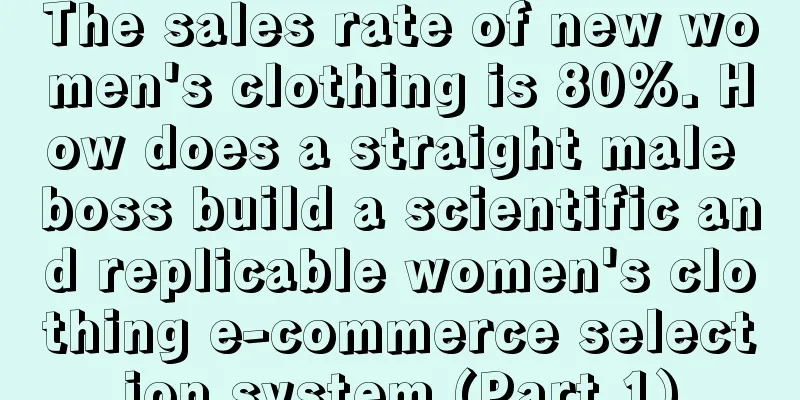Dissemination of scientific and technological elements: dangers and opportunities for domestic brands

01The past two years can be said to be a turbulent period for domestic brands. On the one hand, it is a good thing that more and more domestic brands are beginning to stand out and attract widespread attention and discussion, such as Tianfu Cola at the beginning of this year, and the joint live broadcasts of a number of brands such as Fenghua, Jingxi, and Hongxing Erke some time ago. Another example is the 40th anniversary celebration of Jie Rou in recent days. A number of domestic brands were specially invited to the stage to emphasize that "every conscientious domestic brand deserves to be seen". #Domestic products have power# and #Half of the domestic brand circle is in Guangzhou Tower# immediately became hot searches on Weibo, and consumers are becoming more and more recognized for domestic brands. However, on the other hand, many domestic brands have been questioned about their product strength and brand strength. For example, the huge public opinion storm caused by users complaining that Huaxizi's 79 yuan eyebrow pencil was too expensive, and in the past two days, NetEase Yanxuan's 1,399 down jacket was criticized for being too expensive. For a long time, in the minds of consumers, the so-called conscientious domestic products are those with good basic quality, low price and high cost performance. However, once these domestic brands launch products with higher quality and higher prices, the light of domestic products that were still sought after by consumers yesterday will immediately be at risk of becoming a "tax on IQ" and "scam". However, from the perspective of business operations, if a brand wants to have greater room for development, it is not enough to just take advantage of low prices. The brand must move up and must upgrade. Cheapness will only lock the brand into a low-tech, low-innovation trap, and eventually it will be defeated by international brands that continue to expand to the low end. Especially with the development of the times and the rise of China, people are paying more and more attention to the field of science and technology, and are proud of the great achievements made by China and Chinese companies in science and technology. They no longer only require domestic brands to be good quality, cheap and genuine, but also to have technical strength and technological innovation that is comparable to or even surpasses international brands. 02If a brand can make consumers feel this technological power, then the brand will be respected and highly sought after by consumers. For example, the recent wave of public opinion and queues caused by Huawei Mate 60 pro, as well as the rise of BYD and a number of domestic new energy vehicle brands. In the past, when consumers bought cars, they were most concerned about functions such as space, power, energy saving, and configuration. Today, when consumers buy cars, they first look at the sense of technology and the degree of intelligence of the car. On October 28 this year, Bilibili held its first scientific event "bilibili Super Science Night" and released the five major scientific focuses for 2023, including AIGC, room temperature superconductivity, brain-computer interface, black holes, controlled nuclear fusion, etc., which attracted a large number of netizens to watch. At the scene, Su Chunlei, an associate researcher at the Institute of Process Engineering of the Chinese Academy of Sciences, took the stage wearing a windbreaker and shared this new nanofiber membrane composite fabric developed by the Chinese Academy of Sciences with the audience and netizens, demonstrating the windproof, waterproof and breathable properties of the windbreaker. At this time, in the barrage and comment areas, the most common message from consumers was "Where is the link?" Moreover, the discerning netizens soon found the brand name Ecobreath on Su Chunlei. Subsequently, the search index of Ecobreath on Taobao climbed by more than 1,000 per day, and #中科院帮你选冲锋衣# became a hot search on Weibo. Ecobreath, the brand of this fabric, urgently opened brand Weibo and online store pre-sale channels to successfully take over this wave of traffic. In this way, a new brand that has not yet started marketing and promotion has been brought to the front of many consumers on Bilibili. Today's consumers have begun to pay more and more attention to the technical content of corporate products and whether the brand has a sense of technology. In particular, the consumption concept of the new generation of young people has changed greatly. Data shows that science and knowledge categories have ranked second in user searches on Bilibili, and related content playback accounts for 41% of Bilibili. Young people not only love to learn and pay attention to cutting-edge scientific content, but are also more willing to support domestic brands with technological strength. This is the mainstream consumer psychology of the current era, and it is also inevitable for the comprehensive rise of Chinese manufacturing and Chinese brands. Under this mainstream social mentality and content consumption preference, improving the technological sense and innovation of products, strengthening technological communication, and thus winning the recognition and resonance of consumers can be said to be the only way for the development of domestic brands, and it is also the biggest dividend for a long time to come. This bonus is not unique to technology products such as cars and mobile phones. It is very important for all walks of life. For example, in recent years, domestic small appliance brands have emerged. Later, we will mention the wonderful cases in the footwear, clothing, and beauty industries. Some time ago, Ye Hongxin, the founder of the domestic hair dryer brand Laifen, became a hot search on Weibo because he revealed in an interview that Laifen spent 10 million on Bilibili and sold 100 million yuan. Many people may still know the Laifen brand as a brainwashing advertisement in elevators, but they don’t know that Laifen has done a lot of work and spent a lot of effort on technology communication, which is more practical for promoting sales. At Laifen’s brand launch conference, there was a short clip that used physical experiments to popularize Laifen’s technological strength, including wind speed, wind force, etc. This clip received a good response on Bilibili. After observing this phenomenon, Laifen repeatedly released this clip video in the following year, and finally achieved an amazing ROI of more than 10% [1]. 03Since 2021, Laifen has begun to strengthen technology communication on Bilibili. In the past two years, it has created more than 70 high-quality hard technology videos, more than ten of which have been viewed over a million times, and the overall data is far higher than the average level of the entire site[2]. Bilibili has become a very high-quality platform for Laifen to communicate technology and let consumers perceive and experience it. It can be said that today, more and more domestic brands have the international first-line technological strength. But frankly speaking, most brands are not good at technology communication. They have superb technology but consumers cannot feel it. Today, when technology communication is becoming more and more important, we can only sit and watch the fishermen and envy the fish. There are objective reasons for this, because technology is not easy to spread. One reason is that in the traditional era, the information capacity of advertisements was limited. A 15-second TVC or a graphic design could not clearly explain the complex technical selling points and technical principles. Technology needs more sufficient information and richer and more diverse content forms to carry it. Second, the media environment does not allow it. In the past, when consumers read or watched an advertisement, they were either busy doing other things in daily life, such as elevators, subways, bus shelters, etc., or they were watching TV series, eating melons, or watching short videos in entertainment scenes, such as traditional TV, newspapers and magazines, as well as new media platforms such as Douyin and Kuaishou. In this media environment, consumers have neither the interest nor the patience to read companies’ lengthy technical explanations and popular science content, and can only accept the most superficial advertisements and entertaining marketing information. The ultimate goal of technology communication is to win the recognition and trust of consumers. However, if only the companies themselves publicize their own technological strengths, it is inevitable that they will be seen as self-promotion. At this time, companies need some professional and authoritative third-party platforms and personnel to participate in technology communication, but it is not easy to find such a third party who has both professional qualities and good communication skills. But today, all this is becoming a thing of the past. Consumers are more willing to pay attention to and talk about technology, we have platforms and content formats that are more suitable for spreading technology, and a large number of brands have made wonderful demonstrations and case guidance. It can be said that the right time, right place and right people are all in place. 04Against this major trend and backdrop, I would like to share with you three key points for effective science and technology communication. 1. Science and technology communication needs branding and IPUnlike topics, events, and viral videos, which can be detonated in one wave, technology communication must be carried out for a long time and persistently due to its complexity and huge amount of information. And if this long-term communication is to form a cumulative effect and precipitate brand assets, it is necessary to conceptualize and symbolize the corporate technology. For example, taking a concise and easy-to-remember name and designing a distinctive and highly recognizable visual symbol can reflect the core functions, roles and characteristics of technology, so as to facilitate consumers to form cognition and memory. In other words, technology needs to be branded, from a single technology popularization to the creation of technology brands. For example, Audi has a four-wheel drive technology quattro, which uses a gecko as a symbol, because the gecko can make people think of the grip of the four-wheel drive. I believe that everyone has seen this gecko in the trunk of many cars. This is the communication power of Audi technology. Another example is BYD, which has created three major technology brands, Blade Battery, Yi Sifang, and Yunnian, which have established BYD's status and social influence in the field of electric vehicles. Blade Battery is particularly popular, allowing consumers to have a deep understanding of BYD's battery technology and safety. Technology itself needs to be branded, and technology communication needs to be IP-based. For example, many car companies are now creating their own technology festivals, which are held at fixed times every year to release the latest technologies and products, turning technology communication activities into a fixed, continuously operated festival for the company and becoming part of the brand assets, such as Xiaopeng's 1024 Technology Day, Changan Automobile's annual technology ecosystem conference, and Great Wall Motors' 8th Technology Festival. Previously, in order to promote its E series electric vehicles, Baojun Automobile made the 21st of each month the company's official "Love E Day". On this day of each month, various user activities and product test drives are held, car purchase benefits are distributed, and the company's internal doctoral and designer groups are launched to live broadcast and explain their own technology and car design. This is an IP. As mentioned earlier, technology communication is not only about high-tech products, but also critical to various daily necessities in our lives. For example, Nike, everyone knows that it has a classic technology brand "Air". In 1987, Nike visualized the Air cushion and launched a new shoe Air Max 1. The success of "Air" has contributed a lot to Nike's shoe business. In order to respond to Nike's technological offensive, Reebok also created a technology brand called "Pump". Nike allows consumers to step on the air under their feet, while Reebok changed its mind and made the shoe body inflatable. Users can inflate the shoe by pressing the air pump on the tongue to adjust the shoe's wrapping and fit. So Reebok named this technology "Pump", which is a very resounding name that vividly reflects Reebok's technical characteristics, and as an action, it is very vivid and dynamic. In order to promote "Pump", Reebok created a series of advertisements called "Pump Up & Air Out", which were launched on a large scale to fully cover consumers. In response to Nike's use of Jordan as its spokesperson at the time, Reebok invited other NBA superstars Wilkins and Rodman, tennis Grand Slam winner John Depp, and all-star lineups from golf, NFL and other events to endorse "Pump". In the 1991 NBA All-Star Slam Dunk Contest, contestant Dee Brown wore Reebok shoes and inflated his shoes before each dunk, eventually winning the championship. This event was very topical, and the American audience immediately remembered "Pump". "Pump" also helped Reebok achieve great success in the 1990s [3]. Not long ago, Anta's new CEO Xu Yang was interviewed by "Late Post" and mentioned Anta's product strategy in the interview. He said that in the past, Anta had almost only two kinds of clothes in the summer, round neck T-shirts and lapel T-shirts; what should we do in the summer in the future? We have to sell jackets. Because a T-shirt is only worth 200 yuan, while a jacket can be sold for 300 or 400 yuan at the cheapest. Only by selling jackets can we raise the price. For example, Arc'teryx, another high-end outdoor brand under Anta, almost never sells T-shirts in its stores in the summer, but always sells windproof jackets[4]. But to sell good jackets, you have to convince consumers that you have the technical ability to make good jackets. So Anta launched the "Storm Armor" technology this year, claiming to be "rainproof and comfortable jackets." In order to promote "Storm Armor", Anta teamed up with National Geographic China to create the "A-Travel Around the World" event IP and launched a series of outdoor hiking activities. At the same time, on Bilibili, there are a large number of videos about the technical interpretation, product testing, etc. of Storm Armor. Many up-hosts call it a "bird shell substitute", completing a very successful wave of technology hype. Xu Yang also mentioned in the interview that next summer, Anta will also launch the "Air Armor" series of products. Now Anta's research and development capabilities can achieve the same effect as the highly respected Gore-Tex. Although the Anta brand defines itself as a mass market, it can only keep up with the ever-changing pace of consumers and compete head-on with internationally renowned sports brands by continuously improving its technical strength. In addition, data shows that the average customer unit price of Anta stores has increased to the range of 670-680 yuan by the end of this year, and the next goal is to exceed 800 yuan. This is the value of technology communication. It can not only enable brand promotion, but also make a direct contribution to growth. In Xu Yang's context, he called Storm Armor and Air Armor "commodity IP", and emphasized that there must be IP in Anta's product matrix in the future, and each product must have its own name. Commodity IP is very important to Anta. In my opinion, this is actually a technology brand, as well as the research and development and promotion of new products enabled by technology brands. For example, Anta's "Storm Armor" has hooded jackets, assault jackets, children's lightweight down jackets and other products. In order to better enable product sales and growth, the creation of technology brands needs to be well coordinated and linked with overall brand management and product promotion. In the dissemination of technology brands, the main products should be integrated, and the application scenarios and specific functions of the technology should be interpreted through the products. In the promotion of products, technology brands should also be implanted, and the endorsement of technology should be used to enhance product strength and win user trust. In the overall brand management, it is necessary to plan when to promote the main brand, when to promote products, and when to promote technology brands, and arrange the respective communication rhythms and nodes. For example, the most well-known technology brand "TNGA" under Toyota Motor has the following promotion rhythm in the Chinese market. First, at the Shanghai Auto Show in early 2017, the “2017 TNGA Fengchao Night” brand event was held, during which the Chinese name of TNGA was announced, and two concept cars based on TNGA were launched globally for the first time. Secondly, at the Guangzhou Auto Show at the end of that year, based on the launch of the eighth-generation Camry, the first eight-model mass-produced TNGA model in China, Toyota launched a large-scale communication campaign to promote the TNGA brand. At that time, Toyota produced a large amount of vivid and interesting technology popular science content on Weibo, Zhihu, and Bilibili. Finally, in every product promotion of Toyota, the product positioning will emphasize that the model is based on the TNGA architecture, and the TNGA brand logo and name will appear in a prominent position in the product advertisement. You will find this if you pay attention to Toyota's product advertisements. In the past, when companies mentioned brand building, they often only had product brands and corporate brands as the main brands, but they ignored the fact that the technologies, processes, raw materials, ingredients, and production platforms used in product production can all be branded and built into technology brands. Currently, the automotive industry attaches the most importance to the creation of technology brands, and almost every car company has at least 2-3 technology brands. (Geely Auto Platform Technology Brand: CMA Super Matrix) In Kotler's marketing system, technology brands are "element brands", which means turning an element (technology, raw materials, ingredients, etc.) in the final product into a brand. Intel's "Intel Inside", Lycra fabrics, and Teflon coatings, which we are all familiar with, are all element brands. As a key element in the final product, technology can effectively influence consumers' purchasing decisions and enable companies to enhance their brands and increase their performance. However, at present, many domestic brands do not pay attention to this. Technology can be said to be a blue ocean for domestic brand marketing. 2. Science and technology communication needs to be experientialThe famous director Ang Lee has a widely circulated emoticon package on the Internet, which is called "I don't understand, but I am shocked." In fact, this is the effect that companies want in their technology communication. The goal of technology communication is not to make consumers understand the principles behind technology and remember the various parameters and details of technology, but to make consumers feel the sense of technology, feel the shock brought by technology, and the changes it brings to life. Therefore, for the dissemination of technological elements, the first rule is that what consumers need is perception, not cognition. For example, the smart home appliance brand Dreame once collaborated with the B station home UP host @陈抱一 to create a video. In this video, the UP host did not popularize the technology, nor did he choose to report parameters or list various functional selling points. Instead, he created a 3-meter-long "oil painting" on the floor of his home with soy sauce, which can be called a soy sauce version of "Along the River During the Qingming Festival", and then asked Dreame's mopping robot to clean it all up [5]. This video is lively and interesting, full of life, and not only fully demonstrates the cleaning performance and intelligence of Dreame, but also the visual impact of the 3-meter-long soy sauce picture on consumers directly stimulates the urge to place an order. According to the brand, this video alone brought sales of nearly 8,000 units, and the product was sold out within 3 days, with a ROI of more than 10 and sales of 18 million. For consumers, when they are exposed to hard technology information, intuitive demonstrations, experiments and immersive experiences are far better than simple technical popularization and principle explanations. Like the blade battery mentioned above, many people are impressed by the acupuncture experiment video done by BYD. Therefore, when companies are doing technology communication, they should avoid treating themselves as a high-ranking "teacher" to teach consumers and instill technical knowledge and product selling points. In fact, it is more important to invite consumers to participate and feel and experience technology together. Internet technology is becoming more and more advanced, and the content ecology is becoming more and more abundant. Today's consumers can be said to be well-informed. Old-fashioned and conventional content has become increasingly difficult to attract consumers' attention and interest. Brands must provide consumers with unique and refreshing experiences in order to impress people and win their hearts. This is another very important rule of technology communication. The sense of technology comes from a unique and innovative brand experience. As a brand, it is necessary to think about what new application scenarios its own technology has in the lives of consumers. In specific scenarios, what is the meaning of technology to users and what changes it brings to users' lives? Through this application scenario, consumers get a concrete, tangible, vivid and real experience. Only then will they truly understand, recognize and identify with the company's technology. As mentioned earlier, BYD launched the four-wheel independent motor technology of its high-end brands "Yangwang" and "Yisifang" in January this year. A special application scenario was demonstrated at the press conference. That is, after the vehicle mistakenly enters deep water, Yangwang can enter a floating state based on its good sealing to ensure that the vehicle does not sink. At the same time, the Yisifang technology it carries can also allow the vehicle to move forward, turn and other controls while floating. This emergency floating scene shocked consumers and made them feel the high-end and black technology of Yangwang at once. In Bilibili's "Super Science Night", there is also a popular electric car brand, Avita, which used the "Four High-Difficulty Levels Intelligent Driving Ability Test" to vividly demonstrate that even in the face of racing game-level obstacles, Avita's intelligent technology can easily respond. This wave of operations impressed netizens and boosted the popularity of the Avita brand both inside and outside the site. There is also the mobile phone brand OPPO, which has been focusing on improving its brand performance in the two fields of imaging and folding in the past two years. At the beginning of 2022, OPPO FIND X5 was released, and the focus of product communication was placed on OPPO's self-developed imaging chip. The product appeal is "one frame of image, using two chips". In order to demonstrate its technical strength, OPPO invited its brand spokesperson Jiang Wen to go out to sea by boat and use his mobile phone to shoot the sunrise at sea. In the video, Jiang Wen introduced the entire shooting process in a relaxed and humorous tone, which not only made people feel the imaging performance of the mobile phone, but also reflected the brand's strength and confidence. 3. Science and technology communication requires joint constructionIn the "Super Science Night" of Station B, in addition to Ecobreath, another brand that was widely promoted and brought to the forefront was OLAPLEX. The whole story is like this. First, the well-known UP host @拿拿nah of Station B used her own hair that had been permed and dyed many times, and in front of millions of netizens, she conducted a hair quality comparison experiment before and after the hair mask. Before the hair was washed and treated, it could only lift a maximum of 110 grams, while after the hair was washed and treated, it successfully lifted 140 grams. This intuitive comparison made the audience feel the blessing of the hair mask on the hair quality. Later, another well-known UP host on Bilibili, Lv Yansi (@口口医生这里), who is also a member of the Guangdong Medical Cosmetology and Hair Branch, told everyone that the toughness of hair is closely related to a chemical bond called "disulfide bond", and the hair mask used by Nana contains an ingredient called BDD, which can automatically reconstruct broken disulfide bonds[6]. So netizens began to spontaneously look for hair masks containing BDD ingredients, and finally the hair care brand OLAPLEX took the initiative to claim it and told the netizens who were looking for it: this treasure hair mask is here. A closed loop of technology communication-demand arousal-active search-brand recognition-order purchase has been completed, and a black technology hair care brand has made a shining debut. 05Through this case, you will find that for complex information dissemination such as technology, it requires multiple dimensions and perspectives to interpret, including hardcore evaluations and experiments by professional users, personal experience of ordinary consumers, authoritative testimony from technology workers, and finally the brand's personal testimony and finishing touch. These different sources of information and different content forms enable the integration of a company's technology communication, brand building, product seeding and conversion, and jointly promote sales and growth. The communication master McLuhan has a classic saying - "the medium is the message", which means that the medium itself is also transmitting information. The identity of the communicator and the communication medium used are sometimes more important than the information itself and can have a greater impact on the audience. In marketing, a very simple truth is that third-party and consumer testimonials are more likely to win the recognition of consumers than the brand itself, especially when the third party is a professional or scientific researcher. In the past, companies may be confused about where to find so many third parties who are both professional and knowledgeable about communication, and where to find so many consumers who love to learn and watch technology content. Now, with the emergence of content platforms such as Bilibili, this problem has been solved. For a long time, there has been a joke about Bilibili that "Bilibili is a learning software." In the past year, 243 million users studied on Bilibili, which is 5.5 times the number of college students in China. The learning atmosphere and large user base have attracted more and more experts in the field of science and technology to settle in Bilibili, including academicians of the two academies and Nobel Prize winners. So far, Bilibili has a total of 645 scholars and professors settled in, and more than 3 million knowledge UP hosts. Like the smart home UP host @陈抱一 mentioned above, in another robot vacuum cleaner review video, in order to test the product’s obstacle avoidance effect, he placed more than 20 cans in the living room and let the robot vacuum cleaner do the work. This kind of professional and vivid video is very attractive and persuasive to consumers. Of the 154 videos he has released, 119 have been labeled as “technology”[7]. In the Chinese Internet community, such an atmosphere of knowledge and concentration of technology is very rare and wonderful. Here, "scholars" and "newbies" can communicate cordially, and flowers, applause and doubts and bricks coexist harmoniously. Here, what brands need to do is not only to place brand advertisements and establish cooperation with professional UP hosts, but more importantly, to establish connections with consumers, listen to the opinions and voices of professional users, understand user needs and pain points, and play with users. This is the real co-construction. For example, there is a very famous UP host in the technology area of Bilibili, Film and Television Hurricane. He is very concerned about and passionate about Chinese technology products. His videos have enlightened millions of young people and influenced their consumption and aesthetics of technology products. When DJI launched Pocket 2, Film and Television Hurricane shot a 9-minute review video, analyzing its advantages and disadvantages from all aspects, including the product itself, related accessories, picture quality, sound, battery life, etc., and put forward professional suggestions for improvement. In other review videos, such as the DJI Mini2 drone, Video Hurricane also asks viewers about their willingness to purchase and encourages everyone to type their thoughts on the public screen. As a result, many technology product enthusiasts will leave "essays" of up to 600 to 700 words in the comment section[8]. These videos and comments are actually very valuable first-hand user information for brands. After paying attention to these contents, DJI, as a brand, not only left messages and interacted under the videos through its official account on Bilibili, but also took the initiative to contact Hurricane Film and Television for several hours of in-depth communication, listened to the product suggestions of professional UP masters, and made improvements accordingly in the development and iteration of subsequent products. For enterprises, "Bilibili Inquiry" is becoming a must-have for insight into consumers; and for consumers, the attitude of enterprises to have equal dialogue and communication with UP hosts and users is more likely to gain praise and recognition from users. Because of this, when Bilibili voted for the "Top Ten Most Popular Chinese Products among Young People" in November 2020, the DJI Mavic Mini drone became one of them. Technology communication is not about instilling technology information to consumers in a one-way manner, but about getting consumers involved, playing with technology together, and listening to users' ideas and suggestions. A long time ago, BMW had a professional sub-brand "BMW M". BMW's M models represent high performance, superb craftsmanship, racing genes, exclusive design and personalization. They are an extraordinary presentation of BMW's brand concept of "pure driving pleasure". Its mission is to push BMW's outstanding performance to the peak. In order to promote this technology brand, BMW M has three departments: the Automobile Department is responsible for designing and manufacturing BMW cars with the letter M in their names; the Training Department creates world-class driving training and recruits the world's top car coaches; and the Modification Department is responsible for providing customized models to meet customers' extreme personalized needs. From the setting of this department, we can see that for BMW M, the most important thing may not be to manufacture the ultimate racing car, but to establish connections with car players and build a closer brand relationship. BMW tells us through the setting of its organizational structure that technology is not everything, and playing with consumers is crucial. With the development of the Internet today, brands no longer need to rely on their own strength to do technology communication and user education alone. Instead, they can use the power of the platform, borrow the power of professional users, professional researchers and authoritative research institutions, systematically complete the planting of hard technology strength, and deeply involve users to experience, discuss, share and spread together. When consumers recognize the technical strength of a brand, they will not only buy it themselves, but also become the brand's tap water, actively helping the brand to promote and recommend it. This is the power of co-construction. Over the past 40 years, Made in China has been constantly sublimating into Created in China. The charm of Chinese brands is no longer just about quality and low price, but also about their world-class technological strength, continuous innovation, and continuous leadership in the development of the times. Chinese consumers are no longer just pursuing high cost performance and brand fame, but are more concerned about the unique value of products and advocate brands that truly possess innovative spirit and technological strength. In such an era, continuously improving the technological content of products, building technological element brands, and strengthening technology communication are the future opportunities for Chinese brands, the fundamental basis for winning consumers, and the key to entering the global market and participating in international competition. Author: Kongshou WeChat public account: Kongshou |
<<: Taking advantage of the hot spots, how does Wanglaoji use e-sports to [grasp] young people?
Recommend
Brand personality theory
People with personality are often more likely to b...
Who is being upset by Pinduoduo?
The turmoil of the Pinduoduo "store bombing&q...
How to modify the Shopee store profile picture? How to name it?
After we open a shop on Shopee, we need to set up ...
There are so many outdoor UP hosts, why is Xu Yun the only one who has become the top streamer on Bilibili?
This article focuses on Xu Yun, a top outdoor UP h...
Can I reopen an Amazon account if I cancel it? Which accounts can be canceled?
If you don't use your Amazon account anymore, ...
The exquisite moms on Douyin are really attractive!
Introduction: The deep integration of the e-commer...
The post-00s have taken over the official account. Is the official account suitable for selling cuteness?
Recently, the official account has undergone great...
Is it profitable to open a cross-border e-commerce store on Amazon? How can an individual do well on Amazon?
After we open a store on Amazon, there are many th...
What is the process of opening a cross-border e-commerce store? How to open a store?
There are actually quite a lot of merchants doing ...
Is it good to open a cross-border e-commerce store for free? What do you need to prepare to open a store?
There are still many mainstream platforms in the c...
How much is the commission of Lazada platform? How to calculate Lazada tax?
The Lazada platform charges fees to all sellers. T...
Seeking cooperation when buying a car, but with long payment terms and difficulty in collecting payments, is automotive self-media still a good business?
With the rise of new energy vehicles, the number o...
Share some basic marketing concepts and important marketing theories
Marketing seems simple but it is not simple at all...
In this big year for sports, how can content platforms leverage Olympic traffic?
Why do live broadcasting and rebroadcasting rights...
The best example of catering digitalization, how did McDonald's do digitalization?
As a world-renowned fast food platform, McDonald&#...









